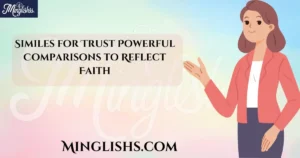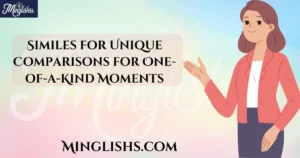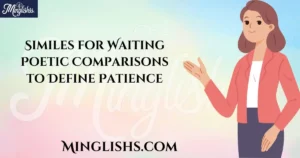“The creative alternatives to express sincerity in your writing or conversations!”
In both personal and professional communications, how you sign off on your message can greatly influence how it is perceived. The traditional “Sincerely” has been a standard closing for formal letters for years, but sometimes, you might want to switch things up and express sincerity in a more personalized or creative way. Using different variations of “Sincerely” allows you to tailor your message to the tone of the conversation, the relationship you have with the recipient, and even the context of your message. This blog will guide you through 35 unique and effective alternatives to “Sincerely,” ensuring your closing feels just right for every situation.
It’s essential to remember that the closing of your message reflects the tone of the entire letter or email. Whether you’re sending a formal business proposal, a heartfelt thank-you note, or a casual email to a friend, your sign-off should align with the message you are conveying. With so many alternatives to choose from, you may be wondering how to pick the best one for your specific context. This guide will help you explore various ways to express your genuine respect, gratitude, and warmth toward your recipient.
Now that you know the importance of choosing the right sign-off, let’s dive into 35 ways to express sincerity. Each alternative is accompanied by an example scenario and some helpful tips to guide your decision-making. Whether you’re drafting an email, writing a letter, or simply looking to vary your communication style, you’ll find the perfect phrase for every occasion.
1. Best Regards
Scenario:
When you’re corresponding with a colleague or business partner about a project, “Best Regards” is a neutral, respectful way to close your email or letter.
Explanation:
“Best Regards” is one of the most versatile alternatives to “Sincerely,” offering both formality and warmth. It works well for professional emails where you want to maintain a polite yet cordial tone. For example, if you’re emailing Sarah to discuss a marketing report, this closing would convey both professionalism and friendly intentions.
Additional Tips:
Use “Best Regards” when you want to be professional without sounding too stiff. It’s great for daily work emails, especially with colleagues you interact with regularly.
2. Kind Regards
Scenario:
Sending a thank-you note after a meeting? “Kind Regards” adds a soft touch of respect, making it perfect for expressing gratitude.
Explanation:
“Kind Regards” is a variation of “Best Regards,” but with a more personal touch. It is commonly used in business settings, but it can also be a great choice for informal communications where you want to come across as polite but warm. If you’re emailing Jack after a meeting, this phrase helps show your appreciation.
Additional Tips:
This sign-off is ideal when communicating with someone you have a friendly relationship with but still want to keep things professional.
3. Yours Truly
Scenario:
When writing a formal letter to a client or someone you don’t know well, “Yours Truly” gives your message a polished and respectful tone.
Explanation:
“Yours Truly” is more formal than “Best Regards” and is suitable for business correspondence or letters to people you don’t interact with often. It’s especially appropriate for formal requests, cover letters, or official communications. For instance, writing a letter to a potential employer about a job application would be an ideal time to use this phrase.
Additional Tips:
This closing is best when you want to maintain a formal and respectful tone. Avoid it in casual or friendly emails as it may sound too stiff.
4. Warm Regards

Scenario:
Sending an email to a team member after a successful project completion? “Warm Regards” adds a touch of friendliness while maintaining professionalism.
Explanation:
“Warm Regards” is perfect for balancing cordiality and professionalism. It’s a slightly more intimate version of “Best Regards” and is appropriate for situations where you want to acknowledge a positive relationship. For example, emailing Kate after a project wrap-up shows both appreciation and respect.
Additional Tips:
Use this phrase when you want to convey warmth and approachability, but without getting overly casual.
5. With Gratitude
Scenario:
If you’re expressing thanks to someone for a favor or kindness, “With Gratitude” emphasizes your sincere appreciation.
Explanation:
“With Gratitude” is an excellent closing when you want to emphasize your thankfulness. It’s perfect for expressing deeper appreciation, such as after receiving a thoughtful gift or an act of kindness. For example, if you are sending a thank-you letter to Frank for his mentorship, this sign-off is appropriate.
Additional Tips:
Pair this closing with a heartfelt message in the body of your email or letter to really drive home your sincerity.
6. Warmest Wishes
Scenario:
When you’re sending a personal letter to a friend or loved one, “Warmest Wishes” is an affectionate and heartfelt closing.
Explanation:
“Warmest Wishes” is informal and personal, making it great for friends and family. It conveys a sense of affection and warmth, perfect for holiday cards, personal letters, or emails to those you hold dear. For instance, when sending a birthday email to Mary, this would express your genuine care.
Additional Tips:
Use this phrase when you want to express closeness and warmth in informal communications.
7. Best Wishes
Scenario:
If you’re wishing someone good luck or success, “Best Wishes” works as a thoughtful and optimistic sign-off.
Explanation:
“Best Wishes” is often used to wish someone well in their endeavors. It’s informal yet respectful and is appropriate when you want to send someone good thoughts for the future. For example, when emailing John about his upcoming promotion, this sign-off shows your support and encouragement.
Additional Tips:
This is a great closing for personal emails, especially when someone is embarking on a new chapter or adventure.
8. With Appreciation
Scenario:
If someone has gone out of their way to help you, “With Appreciation” highlights your genuine thanks.
Explanation:
“With Appreciation” is ideal when you want to show gratitude without being overly formal. It’s often used in business or professional contexts but can also be used in personal situations where someone has done something significant for you. For instance, emailing Alex about a successful partnership can end with this thoughtful closing.
Additional Tips:
Pair this with specific details about what you appreciate to enhance the sincerity of your message.
9. All the Best
Scenario:
If you’re emailing a colleague or friend and want to wish them well, “All the Best” is a casual and friendly closing.
Explanation:
“All the Best” is a warm, informal sign-off that expresses well wishes in a friendly and upbeat manner. It’s suitable for both personal and professional communication when you want to convey your good intentions. For example, when emailing Emily after an event, this closing shows support and kindness.
Additional Tips:
Use this closing for casual interactions or when you feel comfortable with the person you’re communicating with.
Other Ways to Say Sorry for Wasting Your Time
10. Respectfully
Scenario:
In formal communications, especially when dealing with someone in a higher position, “Respectfully” adds a touch of deference.
Explanation:
“Respectfully” is often used in formal letters, especially in situations where you want to show respect to the recipient. It’s commonly used in business correspondence or in situations involving authority figures. For example, when writing to a government official about a proposal, you would use this closing.
Additional Tips:
This closing is best for very formal communications or when addressing someone in a position of authority.
11. Cheers
Scenario:
For informal communication with friends or colleagues, “Cheers” is a casual and upbeat sign-off.
Explanation:
“Cheers” is a great choice for a friendly, informal sign-off. It is commonly used in casual emails, especially when corresponding with close colleagues or friends. If you’re emailing Tom about a social event, “Cheers” works well.
Additional Tips:
This is best used in informal or friendly contexts where the tone is lighthearted and fun.
12. Faithfully
Scenario:
Used in formal letters, particularly when you don’t know the recipient’s name, “Faithfully” is a traditional sign-off.
Explanation:
“Faithfully” is another formal sign-off that you might use when writing to someone whose name you don’t know. It’s typically used in more formal or business-related letters, such as job applications. For example, if you’re sending a formal request to a client, this would be an appropriate closing.
Additional Tips:
It’s best used in situations where the correspondence is official or when you’re addressing someone without personal familiarity.
13. With Best Regards
Scenario:
A more personal version of “Best Regards,” “With Best Regards” can be used when you want to feel a little more personable.
Explanation:
This sign-off adds a touch of personality while maintaining a professional tone. It is commonly used in business emails to clients or colleagues you know well. If you’re emailing Susan about a collaborative project, this sign-off shows both respect and a friendly attitude.
Additional Tips:
Ideal for semi-formal communications, where you want to stay professional yet approachable.
14. Yours Faithfully
Scenario:
Similar to “Yours Truly,” “Yours Faithfully” is used for formal correspondence, often in situations where you don’t know the person’s name.
Explanation:
“Yours Faithfully” is traditionally used in formal letters when you are addressing someone without using their name, such as “Dear Sir or Madam.” It’s often used in business or legal contexts.
Additional Tips:
Use this closing when you want to keep your message respectful, especially in business or legal communication.
15. Looking Forward
Scenario:
If you’re anticipating a response or a future action, “Looking Forward” can be a polite and optimistic sign-off.
Explanation:
“Looking Forward” conveys that you are eagerly awaiting a response, action, or the next steps. It can be used in both formal and informal contexts, especially when you want to convey anticipation or excitement.
Additional Tips:
Use this when you’re eagerly anticipating a response, like waiting for a follow-up email after a job interview.
16. Warmly
Scenario:
If you’re wrapping up a casual email to a colleague or friend, “Warmly” adds a gentle touch of warmth.
Explanation:
“Warmly” is perfect when you want to end an email or letter on a cordial note. It’s a bit more intimate than “Best Regards” but still polite and professional enough for work-related emails.
Additional Tips:
Use this closing for friendly communication that’s slightly more personal but still professional.
17. All My Best
Scenario:
When you’re concluding an email to a close friend or colleague, “All My Best” expresses genuine well wishes.
Explanation:
“All My Best” is another informal sign-off that’s perfect for close colleagues or friends. It conveys a friendly tone while wishing the recipient well. For example, when emailing David after a project milestone, this sign-off emphasizes a personal touch.
Additional Tips:
This closing is best for friendly communication where you want to leave a positive impression without being overly formal.
18. With Respect
Scenario:
If you’re addressing a superior or someone you hold in high regard, “With Respect” adds a touch of reverence and deference.
Explanation:
“With Respect” is often used in formal emails to convey admiration or respect for the recipient. It’s appropriate when communicating with someone in a higher position or someone who deserves a higher level of courtesy, such as a professor or boss. For example, in an email to Dr. Roberts about your thesis, “With Respect” shows deference.
Additional Tips:
Use this when you need to convey a higher level of respect, especially in formal or academic settings.
19. Stay Safe
Scenario:
In times of uncertainty or difficulty, such as during a health crisis, “Stay Safe” is an empathetic and caring closing.
Explanation:
“Stay Safe” is a sign-off often used in more sensitive times, such as during a pandemic or when someone is going through a tough situation. It shows that you care about the person’s well-being. For example, sending a message to Michael during a health crisis would benefit from this closing.
Additional Tips:
This phrase works best when you want to show care and concern for someone’s safety or well-being, especially during challenging times.
20. Take Care

Scenario:
When sending a friendly message to a loved one or close colleague, “Take Care” is casual yet caring.
Explanation:
“Take Care” is informal and caring, often used in personal or friendly communications. It conveys concern for the recipient’s health and well-being. If you’re sending a quick note to your friend Sarah, this sign-off shows you care.
Additional Tips:
This sign-off works well in emails or messages to friends or family members, especially when you want to express genuine care.
21. With Warm Thoughts
Scenario:
In a thoughtful note, such as after a personal conversation or a shared experience, “With Warm Thoughts” adds a tender touch.
Explanation:
“With Warm Thoughts” is an affectionate and gentle closing. It is suitable for sending a message to someone with whom you have a personal connection. For instance, emailing Tim after a vacation trip would benefit from this sign-off, reflecting positive sentiments.
Additional Tips:
This phrase is perfect for conveying positive and heartfelt emotions, especially after a shared experience or special occasion.
22. Take It Easy
Scenario:
If you’re writing a casual email to a friend or colleague, “Take It Easy” is laid-back and friendly.
Explanation:
“Take It Easy” is a relaxed and informal sign-off that works well with people you’re familiar with. It’s great for friendly emails where you want to leave the recipient feeling lighthearted. For example, when emailing Gary about a fun weekend activity, this closing reflects a relaxed mood.
Additional Tips:
Use this when you want your communication to come across as informal and relaxed.
23. In Appreciation
Scenario:
When you’re thanking someone for their hard work, “In Appreciation” conveys a deep level of gratitude.
Explanation:
“In Appreciation” is a formal and respectful way to acknowledge someone’s contributions. This sign-off is suitable for both business and personal communications where the recipient has provided significant help or support. For instance, after a team project, thanking your team members with this sign-off shows your sincere gratitude.
Additional Tips:
This sign-off should be used when you want to emphasize how much you value the recipient’s help or contributions.
24. All My Love
Scenario:
For deeply personal communications, such as letters to a significant other or family, “All My Love” conveys deep affection.
Explanation:
“All My Love” is highly personal and is reserved for situations where you want to convey deep emotional connection. It’s often used in romantic letters or close family emails. For example, a letter to your partner may end with “All My Love” to show emotional closeness.
Additional Tips:
This is a very intimate closing, so be sure to reserve it for those you have a close personal relationship with.
25. With Fondness
Scenario:
When writing to a dear friend or a long-lost relative, “With Fondness” offers a warm and sentimental sign-off.
Explanation:
“With Fondness” is an affectionate closing that conveys a sense of nostalgia and affection. It works well when you’re reconnecting with someone important in your life. For example, when sending a letter to an old friend, this sign-off shows you remember them fondly.
Additional Tips:
This closing is ideal for heartfelt messages or when you’re reminiscing about shared memories.
26. Cheers and Best Wishes
Scenario:
This closing works well for a relaxed and friendly email, particularly when you want to add an extra touch of positivity.
Explanation:
“Cheers and Best Wishes” combines a cheerful tone with well wishes. It’s informal but still conveys positive sentiment. If you’re emailing Jenna after a successful event, this sign-off leaves a warm and positive impression.
Additional Tips:
This closing can be used in emails where you want to express both enthusiasm and best wishes at the same time.
27. Looking Forward to Hearing From You
Scenario:
When you’re awaiting a response or an update, “Looking Forward to Hearing From You” keeps the communication open and encourages a reply.
Explanation:
This sign-off is appropriate when you’re hoping for further communication. It’s a subtle nudge for the recipient to respond and keeps the conversation open. For example, when asking Greg about the next steps in a project, this closing shows anticipation.
Additional Tips:
This phrase is great when you want to encourage action or maintain an open line of communication.
28. Warm Regards and Best Wishes
Scenario:
If you’re looking to convey both respect and warmth in a semi-formal communication, “Warm Regards and Best Wishes” is an excellent choice.
Explanation:
This closing blends respect and warmth, making it ideal for semi-formal settings. It’s appropriate for emails where you want to strike a balance between being polite and approachable. For instance, when emailing Naomi after a productive work session, this closing leaves a positive impression.
Additional Tips:
This sign-off is ideal when you’re building a professional but friendly rapport with the recipient.
29. With Best Intentions
Scenario:
When conveying goodwill or support, “With Best Intentions” reflects sincerity and a desire for positive outcomes.
Explanation:
“With Best Intentions” works well in situations where you want to express that your actions or words are meant to have a positive impact. It’s often used when communicating with clients or colleagues, showing that you care about the outcomes of your collaboration. For example, an email to a colleague about upcoming changes in the project could close with this.
Additional Tips:
Use this when you want to convey that your actions or words are genuinely meant to help or improve a situation.
30. Until We Meet Again
Scenario:
If you’re concluding a letter or email after a meaningful meeting or event, “Until We Meet Again” is a respectful and optimistic farewell.
Explanation:
“Until We Meet Again” suggests that you’re looking forward to a future encounter. It works well in both personal and professional situations where the connection is ongoing. For example, after an insightful business conference with your team, this sign-off can show enthusiasm for future collaboration.
Additional Tips:
This is a thoughtful way to indicate that your communication is part of an ongoing relationship.
31. Best of Luck
Scenario:
When someone is about to embark on a new venture, “Best of Luck” shows your support and well-wishing.
Explanation:
“Best of Luck” is an encouraging and supportive sign-off, often used when someone is about to face a challenge or start something new. For example, if your friend Karen is starting a new job, this closing would show that you’re rooting for her success.
Additional Tips:
Use this sign-off for situations where you want to express positive energy and support for someone’s future endeavors.
32. With Care
Scenario:
“With Care” works well when you’re sending personal notes or updates to people you genuinely care about.
Explanation:
“With Care” is a thoughtful sign-off that adds a layer of warmth and affection. It’s perfect when you want to show that you’ve put thought and consideration into your communication. For example, when sending an update to a friend about a personal situation, this phrase expresses both care and concern.
Additional Tips:
This phrase is great when you want to show extra sensitivity and kindness in your message.
33. Wishing You the Best
Scenario:
When someone is about to experience something significant, such as a trip or big event, “Wishing You the Best” expresses good wishes.
Explanation:
“Wishing You the Best” is a universally friendly and encouraging sign-off. It works well when you want to convey a sense of optimism or goodwill, especially in personal situations. For instance, when sending a letter to a colleague about a vacation, this sign-off shows your excitement for them.
Additional Tips:
This phrase is versatile and can be used in various contexts where you want to send positive energy and encouragement.
34. Farewell for Now
Scenario:
“Farewell for Now” is a warm, casual way to close an email or letter when parting temporarily.
Explanation:
“Farewell for Now” expresses both warmth and optimism, making it great for emails where you’re parting for a while but expect to reconnect later. If you’re wrapping up an email to a close colleague, this phrase shows you’re looking forward to reconnecting.
Additional Tips:
Use this when you want to convey that the communication isn’t final and you expect to be in touch again soon.
35. Until Next Time
Scenario:
When you’re ending a message but plan to continue the conversation later, “Until Next Time” is ideal.
Explanation:
“Until Next Time” works well for those occasions when you know you’ll be in touch again. It’s casual but sincere, making it appropriate for both personal and professional settings. For example, when ending a message to a colleague you’re planning to meet with later in the week, this closing maintains a positive tone.
Additional Tips:
Use this closing when you know that the conversation will continue, either in the near future or at another time.
Pros and Cons of Using These Alternatives to “Sincerely”
Pros:
- Personalized Tone: Many of these alternatives help you tailor your message to the recipient, making your communication more personal and fitting to the context.
- Flexibility: These alternatives allow for flexibility, making your communication versatile and adaptable across various professional and personal scenarios.
- Positive Impact: Using a thoughtful sign-off can enhance relationships and leave a lasting, positive impression.
Cons:
- Overuse: If you frequently use the same alternatives, they may lose their impact and feel less genuine.
- Inappropriate Contexts: Some sign-offs, like “All My Love,” may be too informal for professional or formal contexts, potentially creating an unprofessional tone.
- Cultural Variations: Some sign-offs may not be appropriate across all cultures, and you may need to adjust depending on the recipient’s background.
Conclusion
Choosing the right sign-off is more than just a way to end an email. It’s an opportunity to leave a lasting impression and set the tone for future interactions. While “Sincerely” is a safe choice, there are numerous alternatives available that can add a personal touch, convey warmth, or express your level of formality.
By considering the context, relationship with the recipient, and purpose of the message, you can select the perfect sign-off to enhance your communication. Try experimenting with the options in this guide, and you’ll never run out of ways to end your emails thoughtfully and effectively.

I’m Jane Austen, a language expert at Minglishs, dedicated to helping learners master English through engaging and accessible content. My passion for literature and teaching drives me to make language learning both enjoyable and effective.










